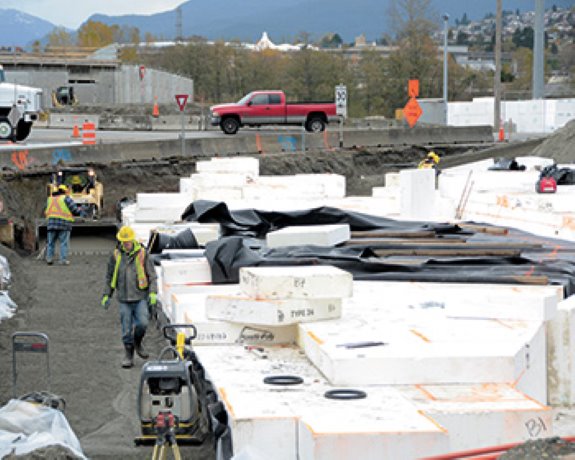The Port Mann Highway 1 (PMH1) Improvement Project is blazing trails to higher seismic standards for embankment construction using expanded polystyrene (EPS) blocks.
EPS is widely used on the PMH1, which is a design-build project. It cuts lengthy pre-load times on poor ground soils.
“Basically, there are not a lot of guidelines for designing embankments and there is no actual code,” said structure engineer and seismic consultant Marc Gerin, now living in Ottawa.
Gerin worked with Hatch Mott MacDonald (HMM) engineers to determine how the 22 large EPS embankments along the 35-kilometre highway could be designed to higher seismic standards.
The guidelines that exist relate to moderate ground shifting and would fall short of the safety requirements needed to sustain the higher seismic ground shifting that could occur using historical data collected from Geological Survey of Canada for the coastal B.C. region.
“We had to develop our own tools for assessment and do our own analysis,” said Gerin, who presented his paper Performance Based Design of EPS Embankments in Regions of High Seismicity at this year’s National Seismic Conference on Bridges and Highways held in Oakland, California last month.
The conference focused on innovation in earthquake engineering and new technologies that provide enhanced seismic safety of highway structures.
“As far as we know, this is the first project to use a performance-based design for EPS, which is a new trend in earthquake engineering,” said Gerin.
In addition, the PMH1 project is believed to be the largest volume user of EPS in North American.
More than 300,000 cubic metres of the material was used. The performance-based guidelines look at downstream objectives and meeting them with an engineered solution rather than following a prescriptive code solution.
The B.C. Ministry of Transportation and Infrastructure wanted two specific seismic standards for embankments, Gerin explained.
The first was that an earthquake causing ground shift experienced once every 475 years should not cause any embankment to suffer more than minimal damage, which could be quickly repaired and would also leave at least half the lanes open to traffic.
Also, a once in 975-year shift could not lead to an embankment collapse.
“In this case, we had to define what was minimal damage,” said Gerin, adding that the performance-based design is harder to achieve, as it impacts not just the embankment, but the highway that had to be kept open.
Gerin used a variation of the Newman sliding block calculation method, which uses block friction to keep the stacks in check.
Each stack was assembled according to a grid pattern. In some cases, vertical concrete panels were used to stabilize the blocks.
He acknowledges that this kind of modeling includes a lot of uncertainty.
“But, in this particular case, we have taken a very simple approach with conservative assumptions built in,” he said.
“We developed a criteria that will meet the performance objective and with our conservative approach the blocks can move more than expected and still be okay.”
A geo-textile membrane (InterWrap Rhino Skin LDPE) protects the EPS, against harmful petroleum products. On top is 600 mm of gravel, 300 mm of concrete slab and 100 mm of asphalt.
While the new seismic standards were a spin-off of the project, the underlying reason for using the EPS was the area’s poor soil quality.
Coquitlam has benefited from the availability of quick construction afforded by EPS.
King Edward was a congested street with an intersection and a rail line as it passed under Highway 1.
The ministry wanted to also eliminate a hump in overpass, so it was decided to bring King Edward over the Highway.
EPS was used to build embankments on either side of the highway because of poor soil conditions. In a 12-week period, they closed the connection between the two approaches.
“There was a chance to fix an old transportation issue,” said Mark Zaborniak, Coquitlam’s manager of design and construction.
“That was a partnership between Kiewit, the province and us.”
EPS was also used on Coquitlam’s Cape Horn Interchange, considered one of the most complex aspects of the construction, as it increased the number of over-and-under connections from four to 15.
“It’s a unique piece of work,” said Aled Griffiths, project manager for Hatch Mott MacDonald.
Traffic had to flow during construction.
“The foam polystyrene was used a lot. The majority of the embankments are of the polystyrene.”











Recent Comments
comments for this post are closed